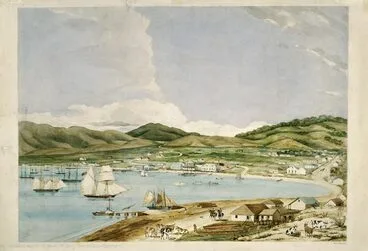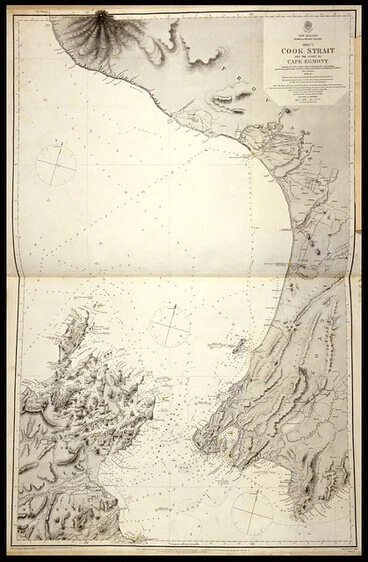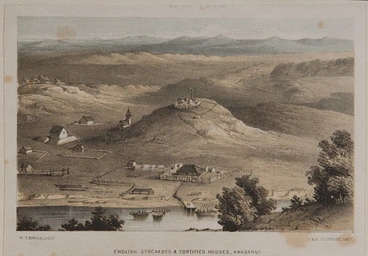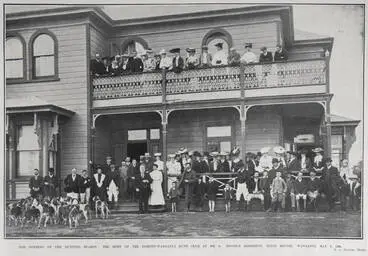"ELIZA TO LORNA" - The Higgie Clan - Part 2 - The Higgies arrive in Wanganui
A DigitalNZ Story by Dan
My great great great grandparents Thomas & Mary Higgie arrived in New Zealand in 1841. The words in this Story are from a book written by my grandmother Lorna Cameron (née Higgie).
Part 2
So it was that in 1849 that they made the journey to Wanganui. Thomas travelled the coastal route, taking with him a herd of cattle for a Captain W.B.Rhodes, while Mary and the children went by Schooner to their new destination.
From Wellington
Collinson, Thomas Bernard 1822-1902 :Continuation of Wellington N. Z. A. Domett's house, 1849. Gov[ernmen]t House (formerly Col. Wakefield's). Ache...
Alexander Turnbull Library
up the coast
Cook Strait and the Coast to Taranaki, 1858
Manatū Taonga, the Ministry for Culture and Heritage
It must have been of great concern for Thomas to discover that he and his big mob of cattle had arrived at Wanganui ahead of his family. The vessel had to shelter behind Kapiti Island due to very stormy weather conditions in the Tasman Ocean. That stretch of water was well known to the Mariners for its treacherous seas. Mary and the children arrived safely and so began the Higgie family on the next stage of their life.
Whanganui town, 1850s
Manatū Taonga, the Ministry for Culture and Heritage
[Taylor, Richard], 1805-1873: Wanganui N. Z. [1848?]
Alexander Turnbull Library
Artist unknown :Wanganui
Alexander Turnbull Library
Photographs of two lithographs of Wanganui
Alexander Turnbull Library
As it turned out it was the right move to make. Thomas bought several sections in Wanganui which became very valuable with the passing of time, and being in the building trade he took every opportunity to better his family’s circumstances in this fast growing settlement. About this time too he built a mill for the Maoris at Putiki, where the Higgie family now lived. It appears that they settled there for several years and the children attended the Putiki Missionary School.
Thomas by this time was 32 years of age, and he and Mary had 5 children. Thomas Jnr.,(8yrs); Mary(6yrs); Alexander(4yrs); Jessie(2yrs); and Christine would have only been a few months old.
Putiki district, Wanganui
Alexander Turnbull Library
Pūtiki pā, about 1850
Manatū Taonga, the Ministry for Culture and Heritage
Pūtiki pā
Manatū Taonga, the Ministry for Culture and Heritage
Thomas continued with his thriving building business which included such large contracts as the Wanganui Hospital, the Barracks for the troops up on Rutland Hill, as well as participating in the formation of the road under Shakespeare Cliff. This very capable, hardworking man must have been a big asset for the growing community.
Rutland stockade and jail, Wanganui
Alexander Turnbull Library
Barracks in the background
[Moutoa Monument, Whanganui]
Auckland War Memorial Museum Tāmaki Paenga Hira
"Making road by Shakespeares Cliff - Thomas Higgie". (Looks like he also worked on a bridge.)
Page 6 Advertisements Column 1 (Wellington Independent, 20 February 1858)
National Library of New Zealand
In 1857, when aged 40 years, Thomas purchased 3,600 acres of land on the No.2 Line Road, just south of Wanganui, a very valuable property which he farmed successfully.
Shows the farm "Higgie's F" on No.2 Line road just SE of Wanganui town center.
Rookes, Charles Cecil, 1819-1909 :[Wanganui Militia districts, showing divisions under Major Rookes and Major Marshall] [ms map] / C.C. Rookes, del...
Alexander Turnbull Library
Their family now numbered eight – 5 boys and 3 girls, as follows :
- Thomas (b.1841)
- Mary (b.1843)
- Alexander (b.1845)
- Jessie (b.1847)
- Christine (b.1849)
- David (b.1850)
- John (b.1853)
- Robert (b.1855)
Destined to be my great-grandfather – then followed James(b.1858), bringing the Higgie Clan to a family of nine children. Thomas Higgie evidently still took time out from farming, from time to time, to take up opportunities to make some extra cash by using his trade skills of Ship Building to great advantage on several occasions. When in 1864 the steamer “Prince Alfred” stranded on the beach near Wanganui, he purchased the abandoned vessel, launched her safely seaward then got her up the Wanganui River where he repaired and refitted the ship.
The wreck of the paddle-wheel steamer 'Prince Alfred ' was sold ... for £420, the purchaser being Mr. Higgie
WELLINGTON. (FROM OUR OWN CORRESPONDENT.) September 11. (Daily Southern Cross, 18 September 1863)
National Library of New Zealand
He then loaded her with cattle and sent the ship on its way to Auckland where the cattle were sold to the British Troops based there at that time……..were those cattle from his farm I wonder? But, that is not all. Afterwards he sold the vessel to the H.M. Commissariat, as a transport ship for the troops, for 4,000 pounds! That to me seems like it would have been a very successful venture for the family. Another time he launched the stranded “Yarra”, again off a near by beach, and no doubt too this ship was sold for a tidy sum of money.
"...wreck of the schooner Yarra, at Wanganui, has been sold to Mr Higgie for £2OO..."
CUSTOMS ENTRIES. (Otago Daily Times, 28 July 1865)
National Library of New Zealand
There is another shipping story I read of recently where he rescued another ship, from the Wellington area, and again it was used to transport cattle, but this time down to the Gold Mines in Otago. It was in the 1850’s when this new venture to the South Island was undertaken. Once the cattle on dry land again his two eldest sons, evidently travelling with the cattle, then drove the herd overland to the Gold Fields! A venture they continued for some number of months. My great-grandfather was surely a most enterprising gentleman – a canny Scotsman!
"...From the run of Messrs. Speed and Higgie, of Wanganui..."
Page 8 Advertisements Column 5 (Otago Daily Times, 15 April 1862)
National Library of New Zealand
Sadly Thomas Higgie suffered illness and, according to his Death Certificate, died from an ulcerated leg, and general debilities, at Okoia, No 2 Line, Wanganui, on 27th September 1884, aged 67. Quoting from the newspaper article of J.G.Woon’s book : “ I knew Thomas Higgie well, and can testify to his industry, enterprise, honesty and integrity. He was a typical Scot of sterling qualities and just the ‘right sort’…”
By the death of Mr Thomas Higgie the Wanganui district loses another of its valued pioneers
DEATH OF MR. THOMAS HIGGIE. (Wanganui Chronicle, 15 March 1919)
National Library of New Zealand
The Higgie estate was divided up amongst his six sons. Thomas, Alexander, David and James Higgie still have some of their land passing down through the generations. But, sadly John died at an early age and my grandfather, Robert, parted with his land in the early 1900’s. There are, I believe, several different versions of John Higgie’s sad demise, when he died on the 20th March 1885, in the ‘Red Lion Hotel’, Wanganui at the age of 32 years. It was barely 6 months after his father’s death. Born in 1853 John was the 7th child of Thomas and Mary Higgie.
John Higgie, well-known in" racing matters, died rather suddenly to-day at the Red Lion Hotel. '
SUDDEN DEATH. (Grey River Argus, 21 March 1885)
National Library of New Zealand
I have, as yet, no information on my great-grandmother Mary Higgie’s activities in and around Wanganui, but on a journey to Wanganui recently, discovered, while researching in the Wanganui Museum, two photos of Mary. Even though I have no written words on her achievements throughout her life I feel sure, with their large family, she would have been just as enterprising as her husband and kept extremely busy maintaining a happy home and family. Mary Clark Higgie died on 16th August 1891, aged 73 years. Both Thomas and Mary Higgie rest in peace in the old Cemetery in Wanganui.
Although well advanced in years, Mrs Higgie enjoyed good health, and it was therefore a surprise to her daughter-in-law
Wanganui Herald. [PUBLISHED DAILY.] MONDAY, AUGUST 17, 1891. RACE DISTINCTION. (Wanganui Herald, 17 August 1891)
National Library of New Zealand
This story is followed by:






![[Moutoa Monument, Whanganui] Image: [Moutoa Monument, Whanganui]](https://thumbnailer.digitalnz.org/?resize=770x&src=https%3A%2F%2Fcollection-api.aucklandmuseum.com%2Frecords%2Fimages%2Fmedium%2F498497%2Fd33e93ed943d100f3f6f6f07bcd302cd52360b3d.jpg&resize=368%253E)
